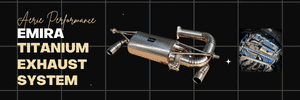Nick in Sydney
Emira Fanatic
This makes a lot of sense to me. It seems that Lotus has worked out that they went too early on pure EV! Maybe they'll put a hybrid engine in the TYP 134 Macan competitor and possibly in the TYP 135 as well?
Below is the transcript of the conversation between Wall Street Journal and Lotus Group CEO Feng Qingfeng (edited):
Q: Why is Lotus planning to introduce super hybrid technology?
Feng Qingfeng: Providing intelligent driving performance for drivers is the cornerstone of Lotus's Vision80 strategy and the brand's mission.
Among them, under pure electric products, the 800V super electric technology allows drivers to experience the purest high-performance experience and extremely fast instantaneous power response; under the hybrid drive system, the 900V super hybrid technology offers flexible power forms, allowing high-performance driving experience and long range to coexist.
Q: What user needs are driving the development of super hybrid technology?
Feng Qingfeng: There are various ways to solve power needs. Many say that fuel vehicles have no future, but I believe fuel vehicles still have a long lifecycle. Lotus users often drive long distances; achieving 20,000 kilometers a year in pure electric is already considered high, but Lotus users average 30,000 kilometers, including regular long-distance driving, especially since drivers enjoy driving, so long range is still very important.
Q: Do luxury car users still have doubts about pure electric vehicles?
Feng Qingfeng: The penetration of pure electric vehicles in the luxury car segment is slow because luxury car engines are already very powerful, and the driving experience is quite similar, with eight-cylinder and twelve-cylinder engines performing well. In the past, low-end cars in China had weak engines, with 0-100 km/h acceleration in 8 seconds being good, but luxury cars are all within 4 seconds, so the demand for power improvement is not obvious
Q: Why haven't overseas luxury brands thought about this issue when they have the same technological system?
Feng Qingfeng: Many countries and regions are talking about electrification, but each country has different demands. China relies on consumer and market-driven electrification; initially, the government provided many subsidies to pull the industry chain together through advantages in batteries, electric control, and software.
With the industry chain in place, the rest relies on market drive. Many foreign countries are not market-driven; Europe’s ban on fuel vehicles stems from emission concerns, with increasingly stringent emission requirements. The Malaysian government is vigorously developing electric vehicles because the country had substantial fuel subsidies, but now that those subsidies are no longer sustainable, they are starting to develop electrification.
Therefore, Europe developed plug-in hybrids early on; electrification addressed legal and regulatory requirements but did not solve pain points. Pure electric vehicles have small battery capacities that require daily charging, and small fuel tanks that need refueling weekly, which instead brings many inconveniences to users, so PHEVs are lukewarm in Europe.
The technological origin in Europe is fuel vehicles, while our technological origin is pure electric vehicles. China always prefers to solve problems based on user needs. The core of the Luyao system is still electricity; I just need to add a fuel system, which easily resolves the electricity issue.
Q: What are the core competitive advantages of Lotus in the new energy sector?
Feng Qingfeng: We still pursue performance. The development of cars can be divided into two categories: increasing functionality or breaking through performance.
When you step on the accelerator, it should be faster, smoother, and more stable, with shorter braking distances and more precise steering; these are performance metrics. Many cars lack any handling capabilities; what Chinese people call comfort is actually a lack of performance. For cars, performance represents safety; the moose test is essentially an emergency avoidance capability.
Regardless of the power form, Lotus can still push the car's performance to the extreme, which is our difference from others.
Q: In what areas will Lotus continue to evolve?
Feng Qingfeng: We are already working on intelligent chassis. Because the weight of the car increases with the use of batteries, handling becomes more difficult, and energy consumption increases. Therefore, we need to enhance safety and handling through intelligent chassis. I believe that in the future of automotive technology, this will become a critical competitive point, so Lotus has early laid out a 6D intelligent chassis and will continue to strengthen this area.
Below is the transcript of the conversation between Wall Street Journal and Lotus Group CEO Feng Qingfeng (edited):
Q: Why is Lotus planning to introduce super hybrid technology?
Feng Qingfeng: Providing intelligent driving performance for drivers is the cornerstone of Lotus's Vision80 strategy and the brand's mission.
Among them, under pure electric products, the 800V super electric technology allows drivers to experience the purest high-performance experience and extremely fast instantaneous power response; under the hybrid drive system, the 900V super hybrid technology offers flexible power forms, allowing high-performance driving experience and long range to coexist.
Q: What user needs are driving the development of super hybrid technology?
Feng Qingfeng: There are various ways to solve power needs. Many say that fuel vehicles have no future, but I believe fuel vehicles still have a long lifecycle. Lotus users often drive long distances; achieving 20,000 kilometers a year in pure electric is already considered high, but Lotus users average 30,000 kilometers, including regular long-distance driving, especially since drivers enjoy driving, so long range is still very important.
Q: Do luxury car users still have doubts about pure electric vehicles?
Feng Qingfeng: The penetration of pure electric vehicles in the luxury car segment is slow because luxury car engines are already very powerful, and the driving experience is quite similar, with eight-cylinder and twelve-cylinder engines performing well. In the past, low-end cars in China had weak engines, with 0-100 km/h acceleration in 8 seconds being good, but luxury cars are all within 4 seconds, so the demand for power improvement is not obvious
Q: Why haven't overseas luxury brands thought about this issue when they have the same technological system?
Feng Qingfeng: Many countries and regions are talking about electrification, but each country has different demands. China relies on consumer and market-driven electrification; initially, the government provided many subsidies to pull the industry chain together through advantages in batteries, electric control, and software.
With the industry chain in place, the rest relies on market drive. Many foreign countries are not market-driven; Europe’s ban on fuel vehicles stems from emission concerns, with increasingly stringent emission requirements. The Malaysian government is vigorously developing electric vehicles because the country had substantial fuel subsidies, but now that those subsidies are no longer sustainable, they are starting to develop electrification.
Therefore, Europe developed plug-in hybrids early on; electrification addressed legal and regulatory requirements but did not solve pain points. Pure electric vehicles have small battery capacities that require daily charging, and small fuel tanks that need refueling weekly, which instead brings many inconveniences to users, so PHEVs are lukewarm in Europe.
The technological origin in Europe is fuel vehicles, while our technological origin is pure electric vehicles. China always prefers to solve problems based on user needs. The core of the Luyao system is still electricity; I just need to add a fuel system, which easily resolves the electricity issue.
Q: What are the core competitive advantages of Lotus in the new energy sector?
Feng Qingfeng: We still pursue performance. The development of cars can be divided into two categories: increasing functionality or breaking through performance.
When you step on the accelerator, it should be faster, smoother, and more stable, with shorter braking distances and more precise steering; these are performance metrics. Many cars lack any handling capabilities; what Chinese people call comfort is actually a lack of performance. For cars, performance represents safety; the moose test is essentially an emergency avoidance capability.
Regardless of the power form, Lotus can still push the car's performance to the extreme, which is our difference from others.
Q: In what areas will Lotus continue to evolve?
Feng Qingfeng: We are already working on intelligent chassis. Because the weight of the car increases with the use of batteries, handling becomes more difficult, and energy consumption increases. Therefore, we need to enhance safety and handling through intelligent chassis. I believe that in the future of automotive technology, this will become a critical competitive point, so Lotus has early laid out a 6D intelligent chassis and will continue to strengthen this area.








